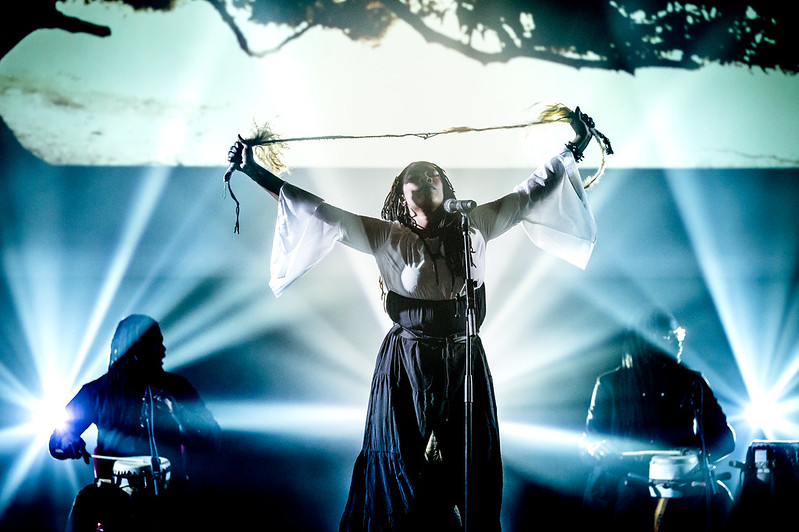Beats Per Minute stumbles deliriously across Utrecht’s foremost experimental festival for hidden and familiar musical wonders.
The Le Guess Who?– festival poster has no names on it. All we see is the artwork: a pink hue behind some kind of fibreglass texture. By now, the Utrecht-based music event can afford to keep the listener in the dark. Its audience is in fact so devoted to the whole experience that they become willing participants in whatever shell game Le Guess Who? has planned next. By now, people better be used to it.
That being said, even the most open-minded listeners have to be challenged now and then with novel ways live music can be experienced. This year Le Guess Who? has introduced The Anonymous Project, a set of three performances done inside of a big cubic structure that gets showered in light projections. This means those who are present at the Grote Zaal won’t have much to look at: just this huge tesseract on stage, and musical sounds emanating from it. It’s easy to get caught up in a guessing game – this festival is called Le Guess Who?, after all – but after awhile the experience becomes hypnotic and strangely devotional. The cube becomes this monolith of sound with everyone gathering around it and listening with intent.
Part of me wonders how it must have been inside the cube: it essentially must seem strange being in a setting that suggests solitude, but instead there’s a whole audience listening in on your performance. Personally, however, I found it hard to lock into the moment: perhaps it was ego or a nagging curiosity, but I had to know. Judging by the blissed out, ambient nature of the music, the first performance could have been Hauschka, Nils Frahm or Yann Tiersen. It may not matter, but what does matter is that the project cuts off the human connection that’s so innately potent in live music. We live in an age where the human-made is perpetually devalued in favor of algorithms and AI-based systems. Which made me realize that, yeah, it actually fucking does matter. Maybe it takes an endeavor like The Anonymous Project to be reminded of that yet again. But, other than that, I honestly don’t grasp the point of it all. Sometimes life’s like a box of chocolates. But sometimes it’s just, well, the box.
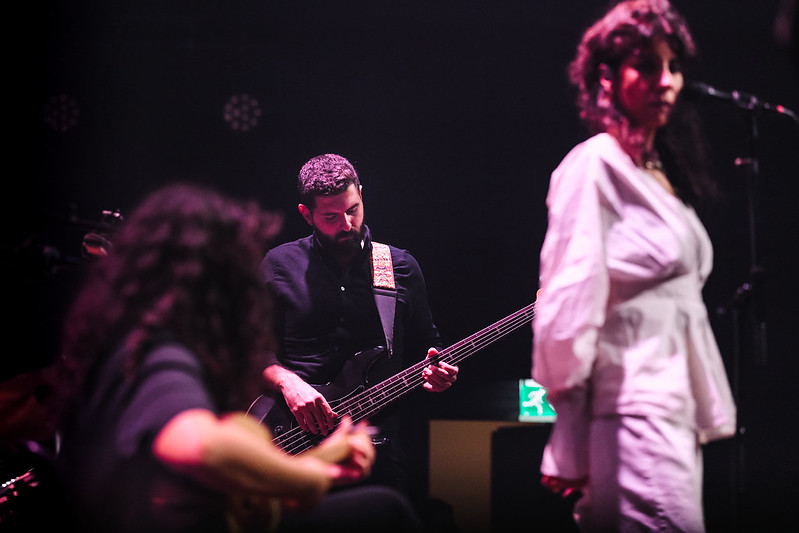
Onwards to see artists with a face. On Thursday at the TivoliVredenburg Pandora stage, we are treated to two experimental rock bands that really have no peer to speak of in terms of sound and execution. Lebanese sextet SANAM‘s serpentine art rock swerves and simmers with aerodynamic precision: sometimes with nimble melodic structures, which, like a billow of birds, can collapse and scatter on a whim, improvising around Sandy Chamoun’s enchanting vocals. In her more free-form, poetic gut-spilling, the rest of instruments – like a parting sea – enshrine her, to moving effect. Denmarks Selvhenter are no less adventurous: their rock abstractions are less erratic, and more hypnotic, unfolding more like self-sustaining spells. You know the term laminar flow, an illusionary phenomenon in which streaming water appears completely solid? Well, Selvhenter are kind of like that. In Tivoli’s larger Ronda venue, the spirits stir in more, let’s say celebratory fashion. Reggae/dub daredevils African Head Charge and Zamrock legends The W.I.T.C.H. gregariously inhale the spirit, inciting their affluent mastery of the groove some more. These revels became a much needed respite from the more experimental acts, once again a telltale sign that Le Guess Who?-artistic director Bob van Heur puts in a shitton of detail on how each night unfolds. There’s Doctor Doom-level prep time in the level of care here, make no mistake.
On Friday in the Janskerk, we amble into the effervescent Youniverse of Maroulita de Kol. The Greek vocalist draws essence from the well of hymns from the Byzantine age of yore, and pours it into a more modern new age-y shell. And we, the audience, are gulping it up, caught in some sort of mesmeric trance. I felt like Pete in O Brother, Where Art Thou? about to turn into a frog. Similarly spellbinding at the Janskerk was Benju-master Ustad Noor Bakhsh, whose swelling notes seemed to snowball within the acoustics of the church. If you closed your eyes, you’d certainly believe the musicians would have multiplied throughout the set, as the Balochi melodies seem to become sentient. There are no looping stations here, just for the record.
Brooklyn-rapper MIKE‘s show at Pandora is quite the opposite of the sometimes opaque nature of his records: ruminations inward turn into primal screams outward, and yes, even a little showmanship and crowd hijinks to ante up the vibe. MIKE is really happy to be here, and he leaves no opportunity unchecked to let everyone know about it. Zambian-Canadian rapper/producer Backxwash‘s music may be much heavier and gnarlier, but in essence, her lyrical approach isn’t all that different from MIKE’s, mining emotions from her most harrowing experiences of oppression, and molding them into soul-burrowing lyrical incursions. Compared to her debut set at Roadburn, you can clearly tell Ashanti Mutinta has had some reps in as a performer, as an extension to her already towering charisma. When she descends into the crowd for “Devil In The Moshpit”, pandemonium is unleashed.
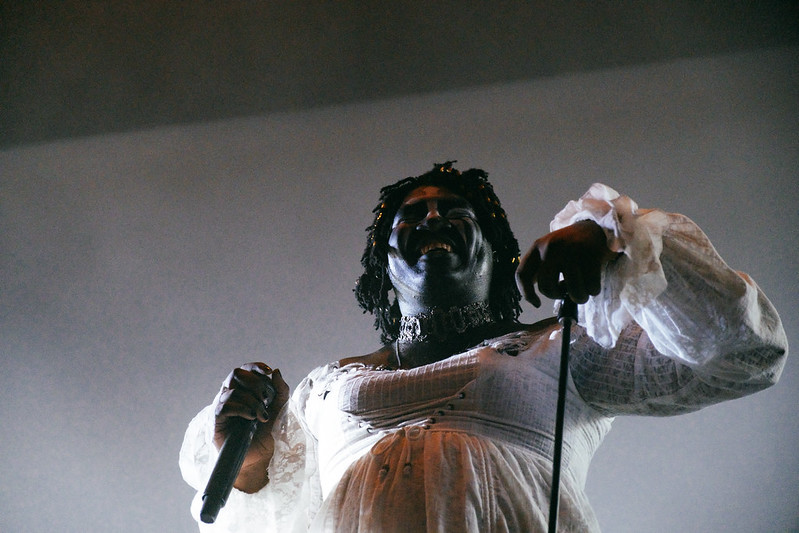
No rest for the wicked as we ascend to Kelman Duran‘s jagged dancehall transmutations at the Cloud Nine, which get plenty people bouncin’ and bobbin’. Back down in the Ronda, Deena Abdelwahed‘s taut, noise-laden digi-folk strikes body and mind with the splendor and sharpness of chiseled crystal. Both these artists are heady alchemists who go to greater lengths to shatter sonic limitations, one leg in the past and one planted in the future.
Saturday’s free U?-program – one of Le Guess Who?’s recurring satellite events – offered plenty of greatness as well. At LE:EN, Rotterdam compadres – with bass player Kat Kalkman doing double duty – Library Card and Neighbours Burning Neighbours produced loud, endlessly satisfying sets, proving once again that heavier music doesn’t have to be a complete downer. Curiously sandwiched in-between these noisemakers were Kim David Bots and Lyckle De Jong weaving deliciously goofy soundscapes: the first two birdbrained explorers of an ecologically intact ecosystem between the realms of Mark Mothersbaugh and Meredith Monk.
I found myself sufficiently amused at the EKKO when Baskot Lel Baltageyya – the project of Egyptian artist Adham Zidhan – took the stage. Think of Middle Eastern folk influences laced with the kind of zany, slightly depraved genre-hopping humor of Ween, and it would be a, rather admittedly, crude approximation of Baskot’s super original take on pop music. Their whole stage schtick is brimmed with vaudevillian charm: one band member stands with the back to the crowd, yet wears a reverse suit plus spectre mask behind the head. One of those acts that would make any festival a more joyous experience.
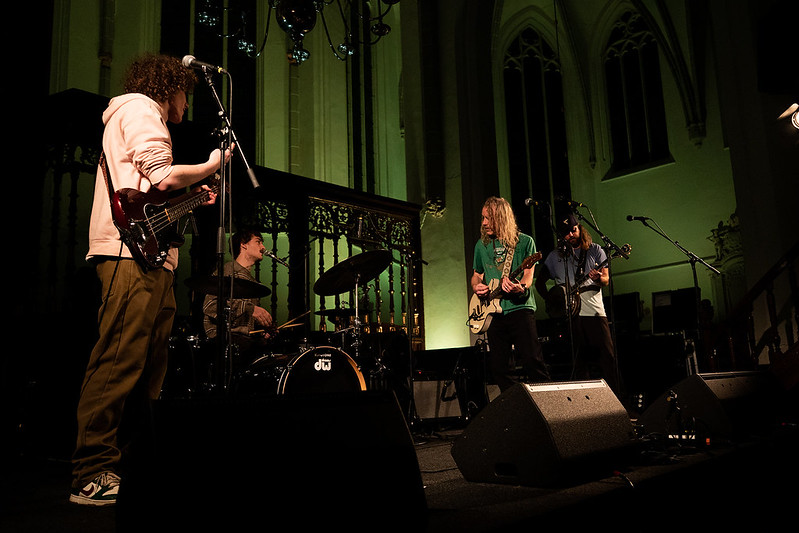
After all that frolicsome fun, it was time to brace for something a little more heavy. For the first time in Europe, Alan Sparhawk performs without his deceased musical soulmate Mimi Parker, with whom he formed slowcore greats Low – who were supposed to headline Le Guess Who? last year. At the Jacobikerk, Sparhawk is surrounded by three band members: Dave Carroll on banjo, Owen Mahon and his son Cyrus. As said before, Le Guess Who?-audiences are used to a lot: most would likely remember Phil Elverum’s performance as Mount Eerie astonishingly naked unfurling of grief, which would later be sealed into eternity in the live album (After).
This show was different however: the band initially do sort of a feel-good, bar band jam, which is a rather odd contrast to the Jacobikerk’s majestic setting. Still, even this felt a bit voyeuristic and intimate: you get the sense that Sparhawk and his band would have played the same way if they were huddled together in a rehearsal space. Some onlookers even start to move their feet; but what transpired next is kind of like those Roadrunner-cartoon gaffes: you’re cruising on solid ground until you realize you shot off a cliff, touching the empty space beneath. The pleasantries become a thin veneer that would waver at any second. It was impossible to keep your eyes dry once Sparhawk and his band switched gears, wringing out barren blues hymns that seem to scream in malediction at the very heavens. One song called “Home 2 Me” saw Sparhawk and his son harmonizing the words “Go let it out”. And we followed suit. A stunning, devastatingly candid expulsion of loss.
We were quickly shocked back into our system witnessing Nihiloxica, one of the more physically punishing live acts on this year’s lineup. The timing was perfect for them to do their thing: deep into the Saturday night, when aching bones and numbed flesh start to protest against all the festival wear and tear. At this point, you’re not exactly pining for a Bugandan drum assault to bludgeon you some more. But Nihiloxica are such a thrilling live act, that you start relishing the assault in some sort of strange masochistic way. For the record, Nihiloxica are heavier and more dangerous than any ‘rock’ band out there, and their traditional pulse works in hefty harmony with the fringe electronics without it ever feeling contrived.
On Sunday, French-Senegalese collective Ndox Electrique seem kindred in their intent to make their live show one long, heart-racing ritual. They harness a strange mixture of elements that miraculously works: hair-raising vocal chants, maddened dance choreographies and weirdly enough, a bit of Eurovision-pastiche to make things interesting. A riveting performance, both sonically and visually.
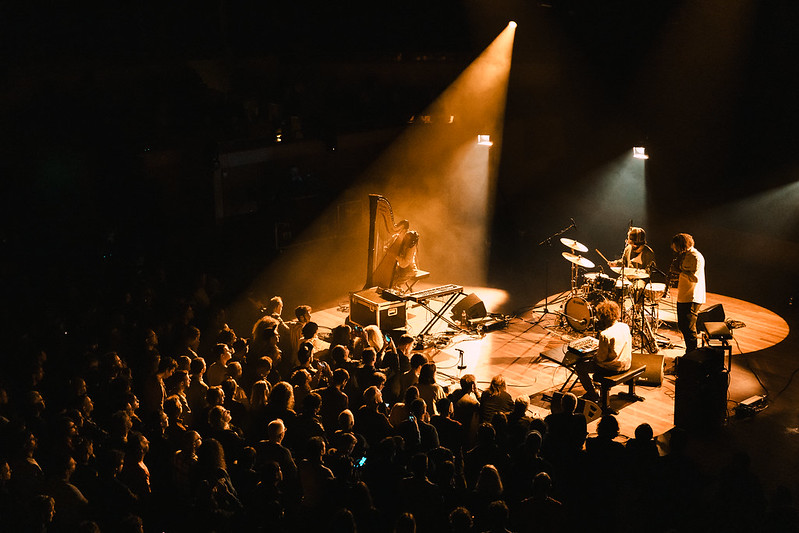
The show that shook many heads in disbelief was co-curator Nala Sinephro‘s performance at the Grote Zaal. Sinephro and her band churn out cosmic jazz movements almost kaleidoscopic in crispness and precision, each note played with consideration and weightless clarity. It’s an oasis for your ears, a constantly morphing sonic roadmap converted into live music, full of palatable textures and sounds. This performance instills the kind of deep, attentive listening that records like Talk Talk’s Laughing Stock inspire, except this music isn’t quote-unquote ‘impossible to recreate live’ but unraveling right before our very eyes. Sinephro alternated seamlessly between instruments – most notably harp and modular synths – with the unhurried disposition of someone tending to her garden. The payoff is there too: Sinephro and her band members finally deciding to turn the screws on their spiritual jazz meanderings, I found myself pogoing like a jolly school kid when they finally reached the summit.
After that unbelievable display, the bravado of buzzy industrial punks Model/Actriz fell somewhat flat, although the crowd at the Pandora welcomed them like gladiators from the Roman Empire. It made more sense to tap out with familiar Le Guess Who?-faces Irreversible Entanglements, who neither disappoint nor repeat themselves, partly because their frantic freejazz always manifests from the present’s bleeding edge. Moor Mother‘s words bellow out with conviction and become lightning rods for her bandmates to latch onto. With a preacher’s gravitas she repeats the words “We Can All Be Free”. A promise to live by, one Le Guess Who? will undoubtedly take into account going forward. A promise that, hopefully someday, all of us will learn to get used to.

